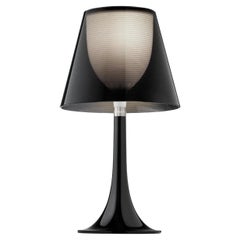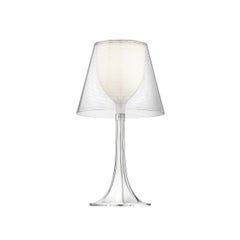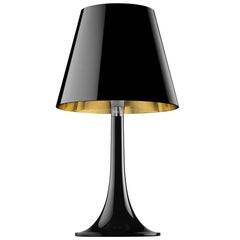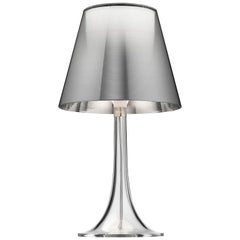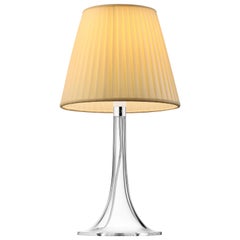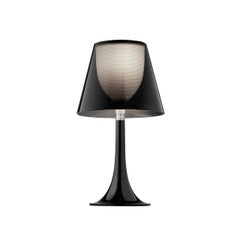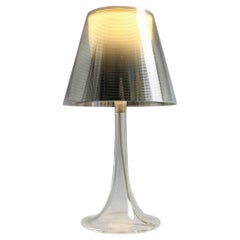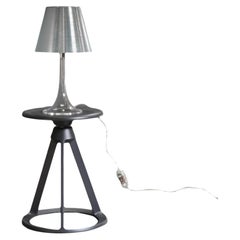Flos Miss K
FLOS Miss K Table Lamp in Fumée by Philippe Starck
By Philippe Starck, Flos
Located in Brooklyn, NY
Created by innovative design master Philippe Starck, the Miss K table lamp brings a delightful
Category
21st Century and Contemporary Italian Modern Table Lamps
Materials
Plastic
Flos Miss K Table Lamp in Transparent by Philippe Starck
By Philippe Starck, Flos
Located in Brooklyn, NY
MISS K desk/table lamp providing diffused light. Fully transparent, injectionmolded PMMA
Category
21st Century and Contemporary Modern Table Lamps
Materials
Plastic
FLOS Miss K Table Lamp in Black by Philippe Starck
By Philippe Starck, Flos
Located in Brooklyn, NY
Created by innovative design master Philippe Starck, the miss K table lamp brings a delightful
Category
21st Century and Contemporary Italian Modern Table Lamps
Materials
Plastic
FLOS Miss K Table Lamp in Aluminized Silver by Philippe Starck
By Philippe Starck, Flos
Located in Brooklyn, NY
Created by innovative design master Philippe Starck, the Miss K table lamp brings a delightful
Category
21st Century and Contemporary Italian Modern Table Lamps
Materials
Plastic
FLOS Miss K Transparent Table Lamp by Philippe Starck
By Philippe Starck, Flos
Located in Brooklyn, NY
Part of the Miss K family, this version of the popular Philippe Starck creation offers a hint of
Category
21st Century and Contemporary Italian Modern Table Lamps
Materials
Plastic, Fabric
Flos Miss K Table Lamp in Fummee by Philippe Starck
By Philippe Starck, Flos
Located in Brooklyn, NY
MISS K desk/table lamp providing diffused light. Fully transparent, injectionmolded PMMA
Category
21st Century and Contemporary Modern Table Lamps
Materials
Plastic
Recent Sales
Philippe Starck Flos Miss K Table Lamp Transparent Grey 21st Century
By Philippe Starck, Flos
Located in Antwerpen, BE
The Miss K table lamp is a design by Philippe Starck, which he created for the Italian lighting
Category
21st Century and Contemporary Italian Modern Table Lamps
Materials
Plexiglass, Plastic
Flos Miss K Table Lamp by Philippe Starck
By Philippe Starck
Located in Basildon, London
The Flos Miss K Table Lamp by Philippe Starck is a contemporary masterpiece that effortlessly
Category
21st Century and Contemporary Italian Modern Table Lamps
Materials
Plastic
Flos Miss K Table Lamp by Philippe Starck
By Philippe Starck
Located in Basildon, London
The Flos Miss K Table Lamp by Philippe Starck is a contemporary masterpiece that effortlessly
Category
21st Century and Contemporary Italian Modern Table Lamps
Materials
Plastic
Philippe Starck Miss K Aluminized Silver Table Lamp for Flos
By Philippe Starck, Flos
Located in Miami, FL
Miss K aluminized silver table or desk lamp designed by Philippe Starck for Flos.
Created by
Category
2010s Italian Modern Table Lamps
Materials
Plastic
People Also Browsed
Mario Bellini Blue Cotton Velvet Camaleonda Sofa for B&B Italia, 1972, Set Of 7
By B&B Italia, Mario Bellini
Located in Vicenza, IT
Camaleonda sofa, designed by Mario Bellini and manufactured by B&B Italia in 1972.
The set features seven modules with backrest (four big modules and three small ones) and one armres...
Category
Vintage 1970s Italian Space Age Sectional Sofas
Materials
Cotton, Velvet, Foam
$41,920 / set
H 26.4 in W 36.2 in D 36.2 in
Forsyth Zebra Hide Pouf Ottoman, Made To Order
Located in SAINT LOUIS, MO
Our zebra pouf ottomans are handcrafted from our beautiful Forsyth zebra hides. The most beautiful zebra hides are selected, handcut, handstitched, and hand stuffed. Each step is met...
Category
2010s American Ottomans and Poufs
Materials
Zebra Hide
USM Haller Serving Cart L 18
By Paul Schaerer, Fritz Haller, Usm Haller
Located in New York, NY
Offered by M2L.
With handle and casters. Designed by Swiss architect Fritz Haller and Paul Schaerer in 1963. Made from powdercoated steel and chrome-plated steel tubes, the USM H...
Category
21st Century and Contemporary Swiss Modern Serving Tables
Materials
Chrome, Steel
French Modernist Iron Table Lamp, 1960s
Located in Vienna, AT
Modernist French iron table lamp with raffia shade, from the 1960s. Blackened wrought-iron base depicting an assemblage of reed and a large raffia shade. Nice original condition with...
Category
Vintage 1960s French Mid-Century Modern Table Lamps
Materials
Iron
Exclusive Set of 6 Murano Tumblers, Burnt Orange Zanfirico over White, Cenedese
By Amelio Cenedese, Amelio Cenedese
Located in Tavarnelle val di Pesa, Florence
Special and exclusive full set of 6 Murano tumblers, Made and Signed by Cenedese.
The pattern of these glasses is a special technique used also by Venini at the time and goes under t...
Category
Mid-20th Century Italian Mid-Century Modern Barware
Materials
Art Glass, Blown Glass, Murano Glass
$2,155 / set
H 3.82 in Dm 3.35 in
Mid-Century Modern Travertine Coffee Table, Italy
Located in Brussels, BE
Mid-Century Modern Travertine Coffee Table, Italy
Category
Vintage 1960s Italian Mid-Century Modern Coffee and Cocktail Tables
Materials
Travertine
Vintage French Coffee Table with Leaf Motif Tiles by Roger Capron (circa 1970s)
By Roger Capron
Located in London, GB
Coffee table with leaf motif earthenware tiles by Roger Capron (circa 1970s). This charming rectangular-shaped low table is a quintessential example of collectible Capron. There are ...
Category
Vintage 1970s French Coffee and Cocktail Tables
Materials
Steel
$3,436
H 12.21 in W 51.58 in D 19.69 in
Huge Vintage Murano Glass Tiered Chandelier -78 glasses
By Mazzega
Located in Gaiarine Frazione Francenigo (TV), IT
Italian vintage chandelier in Murano glass and nickel plated metal structure on 4 levels. The armor polished nickel supports 78 large amber glass tubes in a star shape.
Period:Late X...
Category
Late 20th Century Italian Mid-Century Modern Chandeliers and Pendants
Materials
Blown Glass
Japanese antique long wooden low table/1868-1920/simple design sofa table
Located in Sammu-shi, Chiba
This is a wooden workbench from the first half of the 20th century in Japan, a piece with its stately construction and long history. Katsura and horse chestnut wood are used for the ...
Category
Antique Late 19th Century Japanese Showa Sofa Tables
Materials
Wood
$1,700
H 9.85 in W 70.79 in D 20.08 in
A French Roche Bobois leather sectional sofa.
By Roche Bobois
Located in Philadelphia, PA
A French Roche Bobois leather sectional sofa.
Category
20th Century French Adam Style Sofas
Materials
Leather, Wood
60s Michel Arnoult Brazilian Roxinho Leather + Wood Sling Lounge Chair, EX Cond!
By Michel Arnoult
Located in Basel, BS
Extremely comfortable, rare and beautiful Brazilian beautiful "Roxinho" 1960s designer by chair by Michel Arnoult in excellent vintage condition.
Category
Vintage 1960s Brazilian Mid-Century Modern Lounge Chairs
Materials
Leather, Faux Leather, Hardwood
$1,960 Sale Price
20% Off
H 29 in W 26 in D 28 in
Organic Modern Medium Table Lamp Natural Wood Handmade Ivory Fluted Shade
By Isabel Moncada
Located in San Antonio, TX
PATA DE ELEFANTE MEDIUM table lamp was designed for the Atomic collection by Mexican artist Isabel Moncada.
Named Pata de Elefante –Elephant's Foot– for the prominent shape at its b...
Category
21st Century and Contemporary Mexican Mid-Century Modern Table Lamps
Materials
Textile, Wood, Linen, Fiberglass
$2,500 / item
H 34 in Dm 21 in
Castle Muse Table Lamp
Located in Renton, WA
A term derived from Greek mythology, Muses were nine goddesses, that symbolized the greatest of arts and sciences. Today a Muse is defined as a person or object who is the source of ...
Category
2010s Taiwanese Modern Table Lamps
Materials
Concrete
Poul Henningsen PH 5 Pendant for Louis Poulsen in Hues of Blue
By Louis Poulsen, Poul Henningsen
Located in Glendale, CA
Poul Henningsen PH 5 Pendant for Louis Poulsen in Hues of Blue
Poul Henningsen introduced his iconic 'PH 5' pendant light in 1958. Six decades later, the 'PH 5' remains the bestsell...
Category
21st Century and Contemporary Danish Scandinavian Modern Chandeliers and...
Materials
Steel, Aluminum
Mid Century Campaign Chest by Baker
Located in Palm Beach, FL
Handsome vintage British colonial style chest crafted in walnut with seven drawers having brass campaign hardware and classic turned feet. Perfect marriage of traditional and modern....
Category
20th Century American Mid-Century Modern Dressers
Materials
Walnut
Vintage Set Of Four Afra & Tobia Scarpa "Monk" Chairs for Molteni, 1970s
Located in Nashville, TN
Vintage Set Of Four Afra & Tobia Scarpa "Monk" Chairs for Molteni, 1970s. Solid walnut feet with original cognac leather upholstery. Great patina and wear.
Category
Vintage 1970s European Dining Room Chairs
Materials
Leather
$13,500 / set
H 29 in W 20 in D 18 in
Get Updated with New Arrivals
Save "Flos Miss K", and we’ll notify you when there are new listings in this category.
More Ways To Browse
Mg Wheeler Lamp
Mid Laurel Brutalist N Lamps
Mikado Caccia Dominioni
Min Table
Mirror Black Chinese Lamp
Mission Style Table Lamp
Model 566 Table Lamp By Gino Sarfatti
Modeline Teak Lamp
Moragas Table Lamp
Moroccan Lamp Copper
Moroccan Lamp Shade
Mouse Lamp
Murano Cranberry Lamp
Murano Glass Green Avventurina Lamps
Murano Glass Hat Lamp
Murano Glass Peacock
Murano Leaf Grape
Murano Peacock
